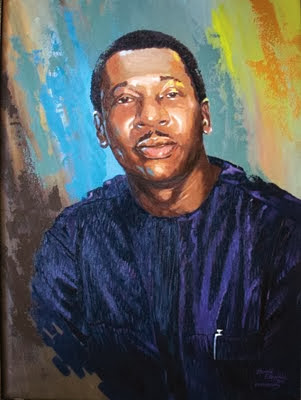By Krydz Ikwuemesi
Painter, art critic and ethno-aesthetician;
Associate Professor, University of Nigeria,
An artistic impression of Areh
Credit:africanartswithtaj.blogspot.com
To mark
the third annual lecture in memory of Peter Dubem Areh on Nov. 23 by 11 am at
the Freedom Park, Lagos, Prince Yemisi Shyllon, humanist and modern Medici, will
discusses the problems militating against the growth and development of art in
Nigeria.
the third annual lecture in memory of Peter Dubem Areh on Nov. 23 by 11 am at
the Freedom Park, Lagos, Prince Yemisi Shyllon, humanist and modern Medici, will
discusses the problems militating against the growth and development of art in
Nigeria.
He
aptly defines development as the movement of phenomena and ideas from one level
of experience to another and links that definition to the art situation in
Nigeria.
Although Nigerian art has advanced since the colonial times, available
indices suggest that there is still room for further improvement. This
conclusion derives from a critical examination of the following factors.
First
are the government and public institutions and the role they can play in art
development. With government’s poor attitude to art and creativity, it is
obvious that public institutions concerned with the promotion of art may not
fare well.
aptly defines development as the movement of phenomena and ideas from one level
of experience to another and links that definition to the art situation in
Nigeria.
Although Nigerian art has advanced since the colonial times, available
indices suggest that there is still room for further improvement. This
conclusion derives from a critical examination of the following factors.
First
are the government and public institutions and the role they can play in art
development. With government’s poor attitude to art and creativity, it is
obvious that public institutions concerned with the promotion of art may not
fare well.
This
is the bane of Nigerian museums, art councils and galleries as they are mired
in bureaucracy, ineptitude and low performance. The situation is then linked to
the system of education in Nigeria with its curricular and philosophy problems.
When
education is a bad mold as in Nigeria, it is bound to yield nothing but bad
casts. This is a fundamental issue for the fact that education circumscribes
and shapes all facets of society. So far, Nigerian education has not conduced
to art development, nor has it benefited from the immense potentials of art as
a catalyst and purveyor of development.
is the bane of Nigerian museums, art councils and galleries as they are mired
in bureaucracy, ineptitude and low performance. The situation is then linked to
the system of education in Nigeria with its curricular and philosophy problems.
When
education is a bad mold as in Nigeria, it is bound to yield nothing but bad
casts. This is a fundamental issue for the fact that education circumscribes
and shapes all facets of society. So far, Nigerian education has not conduced
to art development, nor has it benefited from the immense potentials of art as
a catalyst and purveyor of development.
Next
to this is the problem of historiography, lack of professionalism, and
inadequate resources for cultivating and nurturing a strong and responsive tradition
of writing and documentation. Apart from being a function of the art
curriculum, this is also a reflection of the challenges in the art scene and a
sop to post-colonialism.
to this is the problem of historiography, lack of professionalism, and
inadequate resources for cultivating and nurturing a strong and responsive tradition
of writing and documentation. Apart from being a function of the art
curriculum, this is also a reflection of the challenges in the art scene and a
sop to post-colonialism.
After
all, it behoves the art historian to hold our hands and take us through the
jungle of time so that we can appreciate eras gone by and evaluate our
achievements and failures in light of the realities of history. This factor
conjoins with that of the problem of art criticism, another important
consecrating agency in art ecology.
all, it behoves the art historian to hold our hands and take us through the
jungle of time so that we can appreciate eras gone by and evaluate our
achievements and failures in light of the realities of history. This factor
conjoins with that of the problem of art criticism, another important
consecrating agency in art ecology.
In
places where art criticism thrives, it is a veritable arbiter of taste,
acceptance or otherwise of an artist or art phenomenon. But the critic cannot
operate in a vacuum. His/her performance will be dictated by the reality of
other agencies.
If they are not in top gear, the critical tradition will
suffer, as in Nigeria. In the final analysis, all these factors depend on the
larger society if they are to impact on art as a positive and fructifying
concert of resources.
places where art criticism thrives, it is a veritable arbiter of taste,
acceptance or otherwise of an artist or art phenomenon. But the critic cannot
operate in a vacuum. His/her performance will be dictated by the reality of
other agencies.
If they are not in top gear, the critical tradition will
suffer, as in Nigeria. In the final analysis, all these factors depend on the
larger society if they are to impact on art as a positive and fructifying
concert of resources.
But
the Nigerian society itself has its myriad problems. Those that affect art
development include low level art appreciation, the perception of art as
luxury, and the neglect of the role of art in individual, social and economic
development.
the Nigerian society itself has its myriad problems. Those that affect art
development include low level art appreciation, the perception of art as
luxury, and the neglect of the role of art in individual, social and economic
development.
Also
to be counted is nescience occasioned by the jaundiced eye of the imported
religions which casts aspects of our art in a bad light. All these have held
art development captive in many ways in Nigeria.
to be counted is nescience occasioned by the jaundiced eye of the imported
religions which casts aspects of our art in a bad light. All these have held
art development captive in many ways in Nigeria.
Finally,
the point that Shyllon makes by way of conclusion is that art is not an end in
itself. As a product of society, it relies on society to be able to develop and
play its expected roles in social development.
the point that Shyllon makes by way of conclusion is that art is not an end in
itself. As a product of society, it relies on society to be able to develop and
play its expected roles in social development.
The
sociology of art thus demands a functional art ecology, one in which all
factors and agencies of art development are both active and complementary. As
Shyllon posits, this, however, has not always been the case in Nigeria.
sociology of art thus demands a functional art ecology, one in which all
factors and agencies of art development are both active and complementary. As
Shyllon posits, this, however, has not always been the case in Nigeria.

